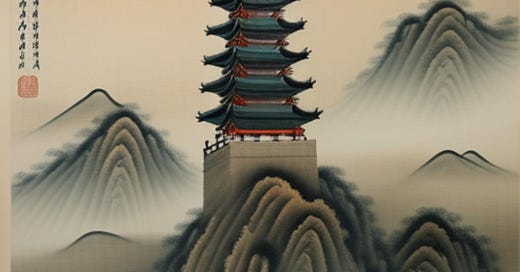Climbing the Tower at the Temple of Blessings with Gao Shi and Xue Jue
Cen Shen
This tower welled up, erupted, surged,
And a palace of the gods emerged:
A spire unmatched in height.
We left the earth behind at its base,
And spiralling through empty space,
We climbed flight after flight.
The land is pinned by this sudden spike
That rears as high as mountains, like
The work of some strange sprite.
Its seven stories scrape the sky,
The flying eaves it’s crested by
Could block the white sun’s flight.
We point to soaring birds below,
And stoop to listen to wind blow
With terrifying might.
We watch the undulating hills
That seem to course like ocean swells
Due east, towards the light,
Great highways lined with leafy green
Link halls and palaces that seem
Exquisite, toylike, slight.
From western mountains, cold creeps in,
Until the river-plain of Qin
Is dim with autumn’s blight,
Though Wuling’s northern royal tombs,
Remain a beacon in the gloom:
An evergreen site.
The way is open to the Pure Land
Through karma, once we understand
It comes from doing right,
So I’ll drop my cap and gown, resign:
In Buddhist study, one may find
We gain the infinite.
岑参 与高适薛据登慈恩寺浮图
塔势如涌出,孤高耸天宫。
登临出世界,磴道盘虚空。
突兀压神州,峥嵘如鬼工。
四角碍白日,七层摩苍穹。
下窥指高鸟,俯听闻惊风。
连山若波涛,奔走似朝东。
青槐夹驰道,宫馆何玲珑。
秋色从西来,苍然满关中。
五陵北原上,万古青濛濛。
净理了可悟,胜因夙所宗。
誓将挂冠去,觉道资无穷。In 752, at the height of the long reign of Emperor Xuanzong, five writers gathered to climb the tallest building in Chang’an, and each wrote a poem to celebrate the occasion. Cen Shen’s verse follows the same model as Gao Shi and Chu Guangxi. He comments on the glorious view, but his special contribution is a series of more dynamic metaphors than anyone else in the group came up with. Cen feels the tower surging upward, and pinning the world. He sees the landscape as rolling like waves on the ocean.
The end of the poem follows the same lame model as Chu: he unconvincingly claims that he’ll go and become a monk himself (it never happened).
A point of interest at the end of this series: one feature that I didn’t manage to bring out in my translations was the rhymes that each poet used. Every poem picks a single rhyme and maintains it through every couplet of the poem. The cumulative effect is very striking. (I reproduced that by having a repeated rhyme in the last line of each stanza.) It’s more than just the repetition, it’s the sounds that the poets picked.
Gao Shi chose the rhyme -ang (so far as we know, prounounced approximately the same in Tang-era Chinese). The feel of “ang” in Chinese is fairly similar to the how it feels in Chinese: clanging, proud, strong. Cen Shen followed Gao closely by choosing the rhyme -ong. Again, it sounds like the tolling of a bell, lound and sonorous. Du Fu, on the other hand, wrote a much more mournful poem, and chose the moaning sound -oh as his rhyme. It’s associated with the blowing of the wind, and coolness. (Chu Guangxi chose the relatively colourless -er/-ay rhyme, which doesn’t have any particular impact.) If I ever revisit these poems, my next goal will be to recreate them in English with similar kinds of rhymes, to match even more closely what the poets were doing.
Notes:
The Temple of Blessings was a major Buddhist temple in Chang’an. The tower that the poets climbed was built during the early Tang, and is still there, today known as Giant Goose Pagoda.
The river plain of Qin is the plain on which Chang’an was built, in modern Shaanxi.
The tombs at Wuling are a complex of imperial tombs from the Han Dynasty.
Pure Land is a reference to Chinese Buddhism. The Pure Land is roughly a kind of heaven.
Karma is a central doctrine of Buddhism, and in the Chinese understanding of karma suggests that doing good deeds causes you to be reborn in the Pure Land.




An other excellent find. He uses "zhong" in the 4th to last line.
Giant Goose Pagoda must have been an amazing sight for people seeing it for the first time.